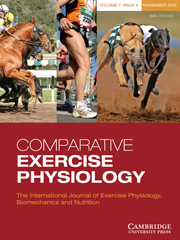Article contents
Is the second week post-race an adequate period to assess the effect of a long-term conditioning on digestive physiology in competing endurance horses?
Published online by Cambridge University Press: 01 November 2008
Abstract
In human athletes, the physiological effects of physical activity on digestion could differ depending on whether it is a bout of exercise or a long-term conditioning. When the aim is to investigate the effect of long-term endurance training on the digestive physiology in competing horses, animals need to be at complete rest during the digestibility and mean retention time (MRT) measurements. We hypothesized that the resting period allowed to horses post-race, and particularly the second week following an endurance race, could be an adequate period to assess digestive physiology and that measurements would still be representative of the pre-competition status. Nutrient total tract apparent digestibility, total MRT and faecal microbial composition and activity measured before a 90 km endurance race were compared with the data obtained post-race, during the second week of the resting period. No differences in the digestibility coefficients, MRT, faecal pH, lactate concentrations and bacterial counts were observed before and after the endurance race. The propionate proportion was higher and the (C2+C4):C3 ratio was lower during the second week post-race than before the race. Carrying out measurements during the second week post-race provides data close to the pre-race status, and avoids an a disturbed training schedule and unnecessary stress before the race in competing endurance horses.
Keywords
- Type
- Research Paper
- Information
- Copyright
- Copyright © Cambridge University Press 2009
References
- 2
- Cited by


